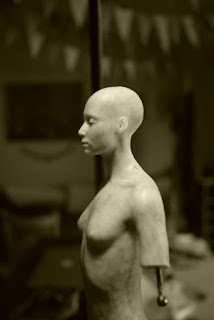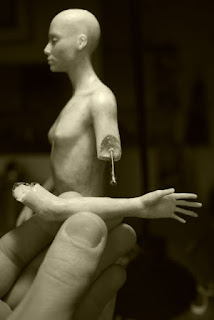I used many sources for her. Looking for a specific kind of beauty is surprisingly challenging. As with Anna, I found quite early on, and felt it more intensely as I went on, that her armature was too large, that she was too tall, and that her proportions were not as I intended. But I put up with this discomfort.
She left Cardiff looking pretty rough, lost her face in Italy, and became herself, looking a little more like Liz than anyone in London.
Isolde
The evolution of a face
early wax sketch bust, much larger than the correct scale, with Lapis Lazuli eyes.
Cardiff
Assisi
I had to force myself to declare her body finished, so that Liz could start taking measurements and work on costume patterns
I married a deeply concentrated perfectionist. Isolde had been lying face down whilst her toiles were being carefully stitched onto her body...
Leaving Italy, heading to London.
London
reworking her profile
Her strange neutral staring expression lacked subtlety and expression. I decided to try lowering her gaze, thinking of a Casorati painting which I love.
Again, repositioning the armature inside the head, which was forcing a larger skull.
I decided to make the cut-off point in the arm above the elbow, as it was easier to connect and disconnect the armature at this point, rather than lower down in the forearm, where there is a complex double bone. And I thought a simple straight line would be problematic when the two parts of skin were joined. I imagined the skin might want to twist and turn at the joining point. Therefore I designed a cut with a flap to key the two parts together.
Later I will find that the silicone bonds perfectly to itself, and that a clean flat line would be much better, much tidier, with a tiny notch or some sort of mark to line the two parts up to.
I had initially thought to make a separate leg with shoeless foot, for a crucial scene in which we see her bare foot. But I couldn't imagine working with a leg and not its body, so I decided just to not shoot her feet when clothed, and keep her secretly barefoot.
Ready to travel to the Scottish borders for mould-making.
Eyes, something I will soon make a new entry about. The beads I used (the only 4mm round beads I could find), were flattened off a little where the hole was. This created a negative cornea, and made it impossible to sculpt a good eyelid. So at some point during sculpture I decided to turn her eyeballs within her skull and use the sides of the balls with no hole, as at least now they were spherical and not concave rather than convex. This is why she had little black dots for pupils, unlike any of the other characters.
Fortunately the black sharpie dots transferred to the resin of the mould, and I was easily able to drill holes into the mould for the pins to support the eyeballs in later casting.






































No comments:
Post a Comment